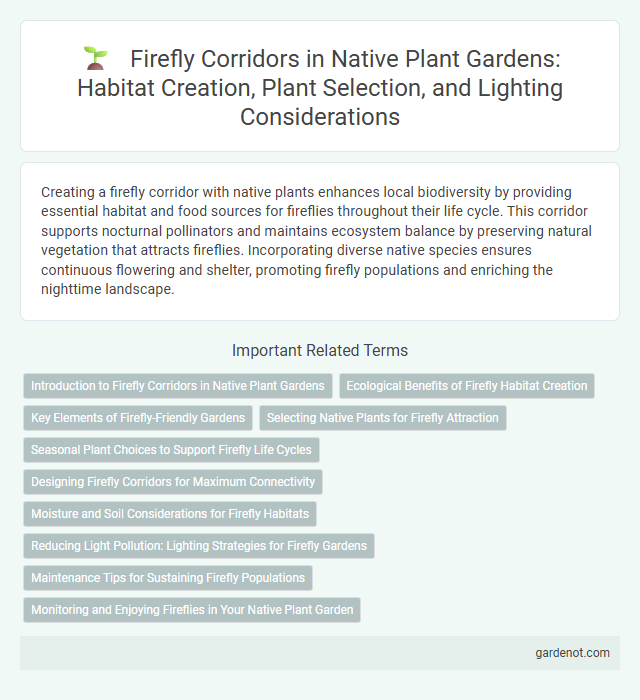Creating a firefly corridor with native plants enhances local biodiversity by providing essential habitat and food sources for fireflies throughout their life cycle. This corridor supports nocturnal pollinators and maintains ecosystem balance by preserving natural vegetation that attracts fireflies. Incorporating diverse native species ensures continuous flowering and shelter, promoting firefly populations and enriching the nighttime landscape.
Introduction to Firefly Corridors in Native Plant Gardens
Firefly corridors in native plant gardens create essential habitats that support the firefly's life cycle by providing native vegetation crucial for mating and larval development. These corridors enhance biodiversity by connecting fragmented green spaces, allowing fireflies to thrive and maintain healthy populations. Incorporating native plants such as milkweed, goldenrod, and wildflowers optimizes habitat quality and attracts fireflies, contributing to ecological balance and nighttime pollination.
Ecological Benefits of Firefly Habitat Creation
Firefly corridors support essential pollination and pest control by fostering native plant diversity and providing critical breeding grounds for fireflies. These habitats enhance soil health and water filtration through the deep root systems of native vegetation, promoting ecosystem resilience. Creating firefly-friendly environments also aids in maintaining nighttime biodiversity, contributing to balanced food webs and overall ecological stability.
Key Elements of Firefly-Friendly Gardens
Firefly-friendly gardens prioritize native plants that provide shelter and food sources like nectar and small insects, fostering a thriving firefly population. Incorporating moist, shaded areas with leaf litter and minimal artificial lighting enhances their natural habitat and encourages mating displays. Creating a continuous corridor of native vegetation ensures connectivity, supporting firefly movement and biodiversity across urban landscapes.
Selecting Native Plants for Firefly Attraction
Selecting native plants for firefly attraction enhances habitat suitability by providing essential food sources and shelter. Species like goldenrod (Solidago spp.), milkweed (Asclepias spp.), and cardinal flower (Lobelia cardinalis) support the insects' larvae and attract adult fireflies with their structure. Incorporating native grasses and moist-loving plants creates a corridor that encourages firefly reproduction and nocturnal activity, boosting local biodiversity.
Seasonal Plant Choices to Support Firefly Life Cycles
Selecting native plants such as goldenrod (Solidago spp.), joe-pye weed (Eutrochium spp.), and swamp milkweed (Asclepias incarnata) creates ideal habitats that support firefly life cycles by providing larval cover and adult nectar sources. Seasonal blooms from spring through late summer ensure sustained food availability and shelter, enhancing mating and egg-laying activities of fireflies. Incorporating damp, shaded areas with leaf litter and tall grasses encourages larval development, increasing local firefly populations.
Designing Firefly Corridors for Maximum Connectivity
Designing firefly corridors for maximum connectivity involves strategically planting native vegetation that supports the fireflies' life cycle and movement patterns. Incorporating a continuous, diverse mix of host plants and nectar sources enhances habitat suitability and encourages population dispersal across fragmented landscapes. Maintaining moisture levels and minimizing artificial light pollution further strengthens corridor effectiveness, promoting firefly reproduction and biodiversity conservation.
Moisture and Soil Considerations for Firefly Habitats
Firefly corridors thrive in moist environments with well-drained, loamy soil rich in organic matter, crucial for larval development and successful breeding. Maintaining consistent soil moisture through natural water retention methods like mulching and native understory planting supports firefly populations. Avoiding soil compaction and chemical runoff preserves habitat quality and sustains the delicate moisture balance necessary for firefly survival.
Reducing Light Pollution: Lighting Strategies for Firefly Gardens
Implementing dark-sky compliant lighting in firefly corridors minimizes light pollution, preserving the natural habitat essential for firefly mating displays. Using motion sensors and low-intensity amber LED lights reduces artificial brightness, enhancing firefly visibility and activity. Native plants also benefit from reduced light interference, maintaining ecological balance within the corridor.
Maintenance Tips for Sustaining Firefly Populations
Maintaining a Firefly corridor requires regular removal of invasive plants to preserve native vegetation crucial for their breeding habitats. Moist, shaded areas with leaf litter must be kept undisturbed to support firefly larvae development and adult emergence. Limiting pesticide use and providing a continuous source of nectar-rich native plants ensures a healthy firefly population over time.
Monitoring and Enjoying Fireflies in Your Native Plant Garden
Monitoring fireflies in your native plant garden involves observing their bioluminescent signals during warm summer evenings, which indicates a healthy ecosystem supported by native flora. Creating a firefly corridor with diverse native plants, such as goldenrod and joe-pye weed, provides essential habitats and nourishment for firefly larvae and adults. Enjoying fireflies enhances your connection to local biodiversity and promotes natural pest control in your garden.
Firefly corridor Infographic

 gardenot.com
gardenot.com